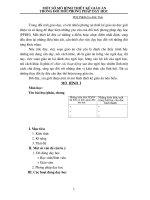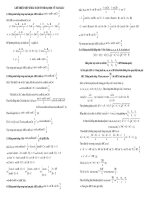- Trang chủ >>
- Đề thi >>
- Đề thi lớp 8
banhbeo’s blog – bánh bèo xin giới thiệu một số tài liệu pr event do bánh bèo sưu tầm được bạn nào muốn share về blog hay website của mình vui lòng ghi rõ trích nguồn dùm nha 1deve
Bạn đang xem bản rút gọn của tài liệu. Xem và tải ngay bản đầy đủ của tài liệu tại đây (199.5 KB, 2 trang )
<span class='text_page_counter'>(1)</span><div class='page_container' data-page=1>
<b>A GLOSSARY OF PR SPEAK</b>
• <b>Above-the-line campaign: a marketing campaign using only advertising.</b>
• <b>Account: the term used to describe a client or job. In consultancies, “an account</b>
team” refers to the group of PR consultants servicing a particular client.
• <b>Below-the-line campaign: a marketing communications campaign that does not</b>
use advertising. Instead it uses promotional tools such as public relations, direct
marketing and sales promotion.
• <b>Brief: the instructions from a client to a consultancy, or directions communicated</b>
within a PR agency.
• <b>Broadcast: the dissemination of programmes or messages through the media of</b>
radio, internet or television.
• <b>Brainstorming: the creative process of group thinking to stimulate or articulate</b>
ideas on a given subject or problem.
• <b>Client: the organisation or person who employs a PR consultancy.</b>
• <b>Clipping: see Cutting.</b>
• <b>Communication: the credible, honest and timely two-way flow of information</b>
that fosters common understanding and trust.
• <b>Competition: other organisations that represent a threat to a particular business.</b>
• <b>Contract: an agreement made between the PR consultancy and the client</b>
covering areas of agreed objectives, timing, service levels and price.
• <b>Copy: the text produced by a consultancy for a press release or article. Journalists</b>
also refer to their news stories or features as copy.
• <b>Corporate Communication: deliberately planned management of the</b>
communications affecting the perception and image of an organisation.
• <b>Crisis Management: this involves planning and preparing a client for any possible</b>
crisis that is likely to affect the organisation, and how it should communicate to
all its stakeholders during that crisis. This involves training relevant
spokespeople, co-ordinating crisis recovery activities and ensuring a unified,
confident and controlled public image. Crisis management is closely related to
issues management.
• <b>Cue sheet: briefing notes to help a spokesman prepare for an interview with a</b>
journalist. The cues should cover the issues that are likely to arise in the interview
and the approach that should be taken on these issues.
• <b>Cutting: the piece of written material containing messages about the client or its</b>
products or an extract from a paper or magazine regarding a particular account.
Also commonly referred to as ‘clipping’.
• <b>E-pr: the practice of public relations using the internet instead of, or alongside,</b>
traditional media.
• <b>Editorial: written materials composed to communicate a brand to the various</b>
audiences identified by the client and consultancy.
• <b>Embargo: a warning to the media not to publish a news item until the date</b>
specified on the release (usually appears at top of first page of news release or
statement). Journalists usually honour this unofficial agreement.
• <b>Evaluation: measurement of the agreed objectives set by the consultancy and</b>
client prior to the start of an agreed activity like a media relations campaign. The
results of the evaluation are used for future planning and development of the
ongoing PR strategy and to benchmark against overall objectives.
• <b>Exposure: the extent to which the target audience becomes aware of a person,</b>
message, activity, theme or organisation through the efforts of PR. This might be
used as part of the evaluation process.
• <b>Exclusive: a news story offered by a PR practitioner to a single newspaper title,</b>
radio, website, or TV station.
• <b>Feature article: a broad or in-depth newspaper, magazine, internet, radio or TV</b>
article that discusses, analyses or interprets an issue, subject or trend. A feature
generally takes longer to research and produce than a news story.
<b>The Insider’s Guide to PR: Chapter 7</b>
</div>
<span class='text_page_counter'>(2)</span><div class='page_container' data-page=2>
• <b>Financial PR: the efforts of a publicly-held company, or one that is on the way to</b>
a public flotation, to communicate with shareholders, security analysts,
institutional investors and stock exchanges.
• <b>Full Service: a one-stop PR shop which incorporates clients from many different</b>
industry sectors and which offers a range of PR disciplines, and sometimes
in-house design and other services.
• <b>Healthcare PR: specialist PR discipline that communicates about either</b>
prescription only (ethical healthcare) or OTC (over-the-counter) products or
issues, to medical groups, interested third parties or specialist media.
• <b>Integrated campaign: a multidisciplinary approach which uses a number of</b>
marketing communications techniques in order to deliver a consistent set of
messages. The aim is to achieve seamless communication with the audience.
• <b>Internal Communications: information dissemination and flow between an</b>
organisation and its employees. Common tools include newsletters and intranets.
• <b>Logo: A graphic or symbol owned by and representing a company or brand.</b>
• <b>Media Relations: communicating with the media by pro-actively speaking to</b>
journalists and sending out relevant articles to the respective publications,
responding to media enquiries, and providing appropriate information on behalf
of an organisation.
• <b>Messages: agreed words or statements that a client wants to convey to third</b>
parties, like the media or shareholders for example.
• <b>News Release: a written communication sent to all news media. Also known as a</b>
press release.
• <b>Media: channel for the communication of information including newspapers,</b>
magazines, radio, TV, mobile phones and the internet.
• <b>News Conference: the live dissemination of news information by an organisation</b>
to invited media. The format is usually a presentation of information by the
organisation followed by a question and answer session.
• <b>Pitch: when PR consultancies are invited by a prospective client to propose how</b>
they would tackle a given brief.
• <b>Press Pack/Kit: a branded pack handed out to the media by an organisation. It</b>
normally contains background material, photographs, illustrations and news
releases.
• <b>Press Release: see News Release.</b>
• <b>Proposal: document outlining a proposed PR campaign to an existing or potential</b>
client.
• <b>Public Affairs - the process of communicating an organisation’s point of view on</b>
issues or causes to political audiences like MPs and lobbying groups.
• <b>Regulatory News Service(RNS) - RNS is an online application which allows listed</b>
companies or their Advisers to submit announcements to investors and
intermediariaries through the London Stock Exchange.
• <b>Search engines: these allow you to search the contents of the world wide web.</b>
When you key in a search term, you receive a list of items that match your query.
• <b>Sector/trade press: the media relevant to specific audiences. This includes special</b>
interest magazines such as hi-fi magazines for hi-fi enthusiasts. Trade journals are
<i>read for business and professional reasons, for example Electronics Week is read by</i>
electronics engineers.
• <b>Teaser: a promotion that is intended to arouse interest in the main campaign</b>
which follows. It is usually used in media relations.
• <b>Transcript: written outline of a radio or TV broadcast about a client.</b>
• <b>Vertical media: media relating to different market sectors for a product or service.</b>
For example, you can promote a barcode printer in the printing media, packaging
media and food retailing media.
• <b>Viral campaign: a communications campaign which is designed to exploit the</b>
potential of the internet to spread messages rapidly. The audience is encouraged
to pass a message on to all their email contacts.
<i>With special thanks to Fiona Campbell, Senior Lecturer, West Herts College.</i>
<b>The Insider’s Guide to PR: Chapter 7</b>
</div>
<!--links-->









